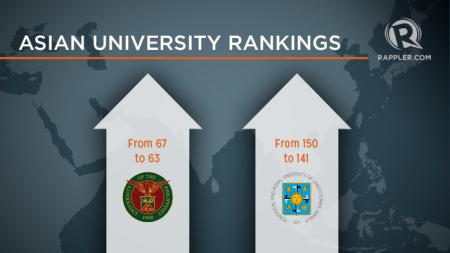- Home
- |
- About Us
- |
- Working Groups
- |
- News
- |
- Rankings
- WEF-Global Competitiveness Report
- Ease of Doing Business Report
- IMD-World Competitiveness Yearbook
- TI-Corruption Perceptions Index
- HF-Economic Freedom Index
- WEF-Global Information Technology Report
- WEF-Travel and Tourism Report
- WIPO-Global Innovation Index
- WB-Logistics Performance Index
- FFP-Fragile States Index
- WEF-Global Enabling Trade Report
- WEF-Global Gender Gap Report
- Gallery
- |
- Downloads
- |
- Contact Us
UP, UST inch higher in Asian university rankings (Rappler)
The University of the Philippines is the only state university among the 5 institutions that make it to the annual rankings
MANILA, Philippines – The University of the Philippines (UP) and the University of Santo Tomas (UST) improved rankings in the 2014 QS University Rankings for Asia released Tuesday, May 13.
They join 3 other Philippine universities in the top 300.
The National University of Singapore, which was only second best in 2013, made it to the top of the annual rankings.
In the Philippines, UP went up from 67 to 63, and UST from 150 to 141. (READ: UP, AdMU, UST lose ground in world rankings)
Ateneo de Manila University (AdMU) fell from 109 to 115, while the De La Salle University (DLSU) remains in the 151-160 ranking.
Ateneo de Davao University joins the top 5 at 251-300 – the same 2013 ranking of the University of Southeastern Philippines which is no longer in the list.
Philippine universities in top 300
| 2014 |
2013 |
Institution |
| 63 |
67 |
University of the Philippines |
| 115 |
109 |
Ateneo de Manila University |
| 141 |
150= |
University of Santo Tomas |
| 151-160 |
151-160 |
De La Salle University |
| 251-300 |
- |
Ateneo de Davao University |
Top 10 ASIAN universities
| 2014 | 2013 | Institution | Country |
| 1 | 2 |
NATIONAL UNIVERSITY OF SINGAPORE |
SINGAPORE |
| 2 | 6 |
KOREA ADVANCED INSTITUTE OF SCIENCE & TECHNOLOGY |
SOUTH KOREA |
| 3 | 2 | UNIVERSITY OF HONGKONG | HONGKONG |
| 4 | 4 | SEOUL NATIONAL UNIVERSITY | SOUTH KOREA |
| 5 | 1 |
THE HONGKONG UNIVERSITY OF SCIENCE AND TECHNOLOGY |
HONGKONG |
| 6 | 7 |
THE CHINESE UNIVERSITY OF HONGKONG |
HONGKONG |
| 7 | 10 |
NANYANG TECHNOLOGICAL UNIVERSITY |
SINGAPORE |
| 8 | 5 | PEKING UNIVERSITY | CHINA |
| 9 | 7 |
POHANG UNIVERSITY OF SCIENCE AND TECHNOLOGY |
SOUTH KOREA |
| 10 | 9 | THE UNIVERSITY OF TOKYO | JAPAN |
The QS University Rankings for Asia, first published in 2009, adopts a methodology that consists of 9 indicators:
- academic reputation (30%)
- employer reputation (10%)
- faculty-student ratio (20%)
- citations per paper (15%)
- papers per faculty (15%)
- international faculty (2.5%)
- international students (2.5%)
- inbound exchange students (2.5%)
- outbound exchange students (2.5%)
UP and internationalization
UP is the only Philippine state university among the 5 institutions that made it to the top 300. Its 2014 Asian ranking is said to be its highest since 2011.
An article posted on the UP website Tuesday quoted UP President Alfredo Pascual as saying the improvement can be attributed to its pursuit of internationalization, among other efforts.
“The improvement in the scores can be attributed to our continuing efforts to increase funds and incentives for research, upgrading our facilities and laboratories, proving support for PhD and Master’s scholarships, recruiting faculty through the Balik-PhD Program and Visiting Professors Program, giving greater incentive for honor graduates to teach in UP, and pursuing internationalization,” he said.
Pascual earlier said UP is "not fully sold on rankings, but it's something we cannot ignore. We'll be ranked, and it will affect our reputation." (READ: The road to ASEAN 2015: Why are PH colleges lagging behind?)
The recent move by the UP system to shift its academic calendar is seen as a "clear signal that UP is now internationalizing and is getting ready to fully engage universities in our partner countries.”
Starting school year 2014-2015, the UP system will adopt an August to July school calendar –the system’s effort to "develop into a regional and global university,” Pascual earlier said. (READ: UP school calendar shift: Who benefits?)
Other universities like the Ateneo de Manila University and the University of Santo Tomas also decided to shift their calendars in response to ASEAN integration and “the increasingly globalized world.” (READ: 8 ways PH higher education can prepare for ASEAN 2015) – Rappler.com
Original Source:
http://www.rappler.com/nation/57891-philippines-universities-2014-qs-university-rankings-asia


